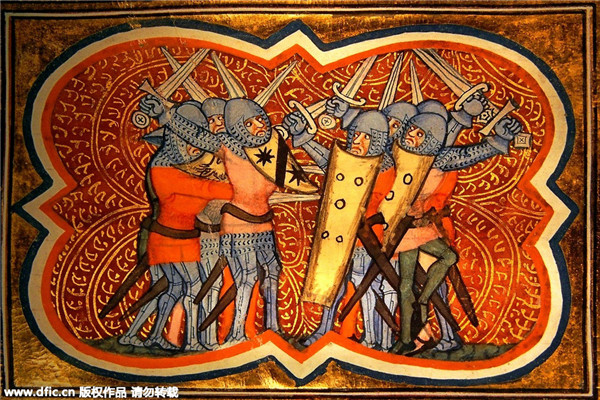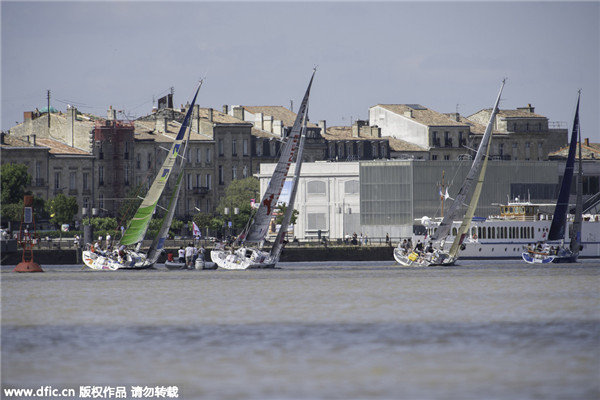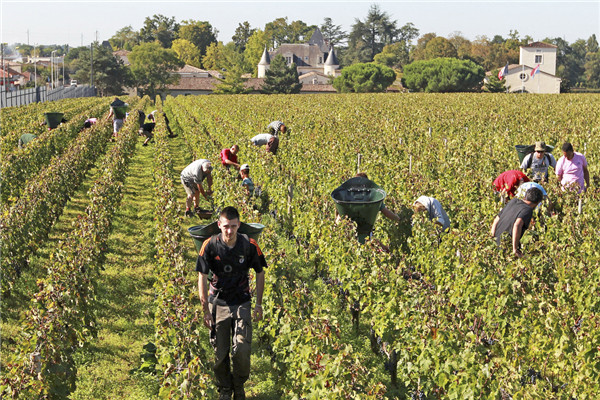Journey to the Silk Road-France
Updated: 2015-06-12 13:28
(chinadaily.com.cn)
|
|||||||||||
 |
 |
Bordeaux Est Beau! (Bordeaux is Beautiful!)
Situated in the southwest of France on the banks of the Garonne river, Bordeaux is famous first for its wine and then for its history. Its name translates to 'Edge of Water'- Bord = edge; d'eau = of water; its nickname is La Belle Endormie– Sleeping Beauty. The weather tends toward the mild: rains during the summer help keep temperatures bearable and, although there is frost during the winter, seldom does it snow.
Established around 300BC by the Celts, Bordeaux has a long and sometimes violent history. Because of the choice lands and agreeable climate, and its proximity to water, the Romans took it by force, circa 60BC. It then fell into the hands of the Vandals - a tribe from Poland, who tried to defend it from the Visigoths, who in turn lost it to the Franks in 498AD. All of this bloodshed means that the city is an archeological treasure trove. Last time I was there, a construction crew had just unearthed a Visigoth boat. How I wish I had that picture to show you!
Bordeaux is full of things to see and do. Most of the historical sites are situated in Le Vieux Carré, or 'Old Town'. There you can see the remains of the medieval city walls and Porte Caihau, an access to the old city. Further down, as you travel along the left bank of the river, you will find the second access to the old city: La Grosse Cloche – The Big Clock, the structure also dating from that time, although the clock dates only to 1759AD. In fact, The Big Clock building was Old Town's belfry tower, and still houses the original bell that weighs in at nearly 8 tons.
 |
|
Detail of 11th century book depicting the feudal system, Archives de Bordeaux, Gironde, Aquitaine, France. [Photo/IC] |
Other historical sites include (clockwise from lower right): Le Palais Gallien, a Roman amphitheater, Cathedrale Saint André (1096), Tour Pey-Berland (1440) – a free-standing spire meant to house the church's bells in order to protect the church from the bells' vibration. It was not put to its intended use until 1851. Other churches, from Roman Catholic to Gothic dot the city. Le Pont de Pierre – Stone Bridge (1819), is significant because it was the first bridge to connect the left and right banks of the river.
Wandering the streets of Old Town will take you back to a time when cities were built with roads as crooked as possible, for better military defense. One alley is so narrow it is called Rue de la Vache – Street of the Cow because it is only wide enough for a cow. Throughout those alleys and cobbled streets you can find funky eateries offering the local specialty: oysters. Plenty of cafés and bistros, too. Most of the buildings in Old Town have retained their original purpose and their charm. Renovations are only so as to ensure the safety of the patrons and afford today's conveniences, like electricity. However, some shops still have their ancient signs and gas lamps or brackets for torches.
And statues! On Place Saint Projet, where a cross denoting a cemetery dating back to 1392 still stands.Throughout parks and around the city, historic statues abound. At Place des Quinconces, the largest public square in Europe, one can find not only the monument erected in memory of fallen citizens but 2 rostral columns facing the river. One represents commerce and the other, navigation. On market days or expositions, this square is filled with a colorful, bazaar-like atmosphere, as vendors shout their prices and people bargain heavily.
 |
|
Rue Ste Catherine, Bordeaux, Gironde Department, Aquitaine, France. [Photo/IC] |
Coming out of Old Town and resuming our walk along the left bank, we come to Place de la Bourse: the Customs building. Bordeaux has the advantage of being only around 50km from the Atlantic. Besides that, the Garonne is wide and deep enough to accommodate ocean liners. It was very convenient for merchant marines to have this major city, the 6th largest in France, so accessible by water. They simply navigated the river's lazy turns. Soon enough, they were docked and off-loading, while the captain of the vessel or the owner of the goods declared their freight in the customs house.
A lot of those goods found buyers in Bordeaux proper. Even today, the city is known for its shopping. Rue Sainte Catherine is the longest pedestrian street in France. I can remember a special birthday treat, when I was a little girl, was wandering down this shopping lane I egoistically thought was named after me (my middle name is spelled the same way). There one can find anything from high-end luxury to everyday needs. La Galerie Bordelaise, a shopping mall opened in 1834, anchors the street to the north, close to the Grand Theatre. There are plenty of fun little shops along the way, too. For bookstores, you should return to the older part of town. While there are such stores along Rue Ste. Catherine, the more eclectic shops for hard-to-find books are more likely to be in the oldest district. Due to France's compulsory 35 hour work week, on any given day you are likely to find people off from work and ambling around that famous street, along the river, through Old Town, or just taking in the scene at any of the many bistros dotted around the city. Tipping is no longer required, but tips will be accepted if offered. You might be pleasantly surprised to find street signs with historical notes written both in French and English.
 |
|
Place de la Victoire, Bordeaux, Gironde Department, Aquitaine, France. [Photo/IC] |
Bordeaux and China: One of this French gem's sister cities is Wuhan. However, most of the migrants from China come primarily from Wenzhou. I could not find any statistics for Chinese in Bordeaux, but the most recent wave of immigrants come to France from the Dongbei (northeast) region, with women largely outnumbering men. The various Chinese 'pockets' are separated both by their culture and language, and by their chosen professions. Those from Dongbei tend to have a higher level of education than those from Wenzhou and thus engage in business or white collar work. Those from Wenzhou prefer trades, especially pottery and food. When I was growing up, I do not recall seeing a single person of Asian descent, let alone one identified as Chinese. That may have changed since Bordeaux has expanded and is so open to business.
 |
|
Illustration sailing in the canal before start of the Solitaire du Figaro in Bordeaux, southwest france on may 29, 2015. [Photo/IC] |
Bordeaux has expanded quite a bit since I've called it home. It now includes several districts that, at the time I lived there were considered suburbs. Thus, the way might take a bit longer but, not far out of town you will see vineyards. Bordeaux wine is top-shelf, Chateau Haut-Brion and Chateau Lafite-Rothschild among them. My cousin, Marie-Hélène works in the vineyards and avers that it is still back breaking labor, in spite of modern techniques and equipment.
My last visit to Bordeaux was to authorise the sale of a family-held property. The City needed it in order to build a parking lot for their newly built tramway, then under construction. While the community had changed quite a lot, my uncle and I were surprised at how much has stayed the same, and how much I remembered. I told him that, next time I visit the whole burg might have changed.
 |
|
This Oct. 7, 2013 file shows workers collecting red grapes in the vineyards during the grape harvest season, in Pessac-Leognan, near Bordeaux, southwestern France. [Photo/IC] |
Indeed: With old and new blending seamlessly, fresh air and blue skies, there is so much to see and do in and around Bordeaux. A few hundred words and some pictures cannot do it justice. You'll just have to go have a look for yourself. Enjoy! Don't forget to take in the stunning courthouse, started by an old fortress and going on to tell the story of 4 brothers, represented by wooden pods, and surrounded by glass.
Today's Top News
Zhou Yongkang sentenced to life in prison
Kiev announces new round of peace talks on Ukraine crisis
Greece, EU powers agree to step up debt talks as crunch looms
EU sanctions hamper Italian-Russian commercial ties: Putin
Suu Kyi begins groundbreaking visit
G7 'ignore the facts over South China Sea'
British PM hails 'golden year' in UK-China relations
China's new rail giant bags first overseas deal from India
Hot Topics
Lunar probe , China growth forecasts, Emission rules get tougher, China seen through 'colored lens', International board,
Editor's Picks

|

|

|

|

|

|






